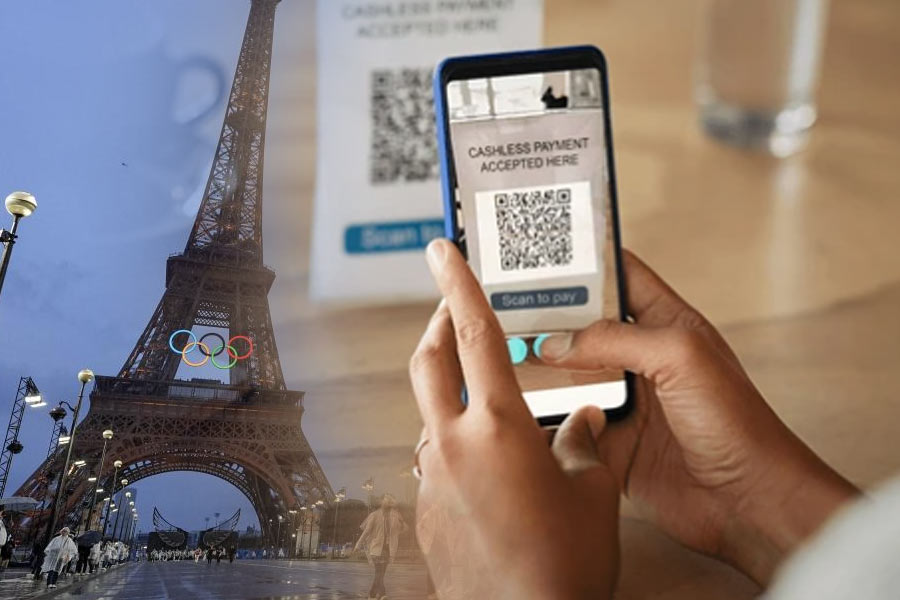I don't know what you are talking about,” says the information desk official at the Eiffel Tower, the iconic engineering marvel, when asked how to buy a ticket using UPI or the QR-code mode of payment.
The Unified Payments Interface (UPI) was introduced in Paris in February this year with an aim to allow Indians to buy tickets to visit the iconic tower without having to worry about currency exchange rates or carrying large amounts of foreign currency.
The Eiffel Tower was the first merchant to offer UPI payments in France, and the service was planned to be extended to other merchants in the tourism and retail space across the country and Europe.
However, the ticket counters at one of the most significant landmarks in Paris, have neither arrangements nor information about whether a Quick Response (QR) code is even an option to buy a ticket.
Hisham Mohammed, who works as a guide at the Eiffel Tower, was pretty excited when he learned that such an option was being made for the Indians.
“Well, it was only in the news. No one knows here about the UPI option,” Hisham, who hails from Hyderabad, told PTI as he waited for his next guided tour of the monument.
“I came running the next day after the announcement but found nothing here. No one had a clue then and no one knows even now.
“We were glad to hear that this was happening. UPI is convenient, but it was all in the news, nothing on the ground,” he said.
However, the official website, www.toureiffel.paris/en offers UPI facility for online ticket booking along with credit and debit cards as options for payment.
But other popular portals like www.eiffeltowertour.com do not offer the UPI payment option.
The guided summit tour through the elevator is priced at Euro 64.
With a record 14.04 billion transactions in India in the month of May - up from 920 million in 2017-18 - UPI's first full of operations, UPI was gone global and is now
available across seven countries - UAE, Nepal, Singapore, Bhutan, Mauritius, Sri Lanka and Thailand where Indian can transact at almost 3 million merchant establishments.
The numbers at Paris currently are insignificant compared to the more than 250 million local QR code points.
EUROPE YET TO WARM-UP TO QR-CODE
India accepted and adapted to this mode of payment quickly when UPI (Unified Payment Interface) was launched in 2016.
However, you would not find a single restaurant or store in Porte Malliot or Champ-Elysees or far-away North/South Paris Arenas where merchants accept this mode of payment.
Akash Sharma, who hails from Mumbai but settled in Antwerp, says that QR codes are available in the place where he works but not for payments.
"You get QR codes to access the menu in restaurants but it is not used for payments. India and China are far ahead on this,” he said as he took the elevator for the Eiffel Tower summit, 276 meters (about 900 feet) from the ground.
Services such as Lime give their customers the option to hire electric scooters for rent in Paris by accepting payment through Apple Pay.
Bettina Camilleri, who works with Eurosport, says dematerialising money is something hard to accept in South Europe, especially for the generation that has grown up.
People in their late 40s or 50s are not inclined to use smartphones for payments.
“It's a very cultural thing. We, the French people, love our cards and cash. Our relationship with money is such that we need to have something (cash) in our hands, feel it,” she said.
“It's probably because we don't feel like it's a secured payment. I think it's coming, but we're going to need some time to get used to it.”
Bettina's logic is not without reason. The QR codes, largely, in Europe are dynamic and thus the URL encoded in them redirects to a second URL that can be changed on demand, even after a code is printed.
Static QR codes can't be changed in that way.
Apple users in Europe have the option of adding their card details in pre-existing apps (Apple pay) and use it for payments.
Louis Lacoche, who is a university student, unlocks his phone and shows how he has stored all his cards.
“It is very convenient. I use my phone to make payments. But I do not know what this QR code is,” he said.
As Bettina says, “The younger people have no problem doing it. They are more flexible. They can do that easily than the grown-ups because it's a habit we are having a hard time getting to. I don't know why.”
Bettina admits it was easy when she used it for the first time.
“My company is using it for a company restaurant. We can pay with our telephone and it works pretty well. But it's an account that we can only use internally. So, in terms of security, it's fine. It's not risky.
“But otherwise, I've never tried it. Basically, it's fear of losing your money, which is stopping people. You have the feeling it's not safe, I think, for people my age.”
Paris has a different system altogether even for paying electricity bills.
“The district town hall will ask our preference how much we want to pay every month. Say, I choose an amount of Euro 50 and at the end of year if I have consumed more electricity than the money I have paid, I will get a link in my email to pay for the balance amount.
“I have to click the link, fill in card details and pay. If I pay more, I will get a refund,” said Archana who runs a restaurant in Porte de Champerret.
Clearly, Europe has not warmed up to QR code.
Except for the headline, this story has not been edited by The Telegraph Online staff and has been published from a syndicated feed.











